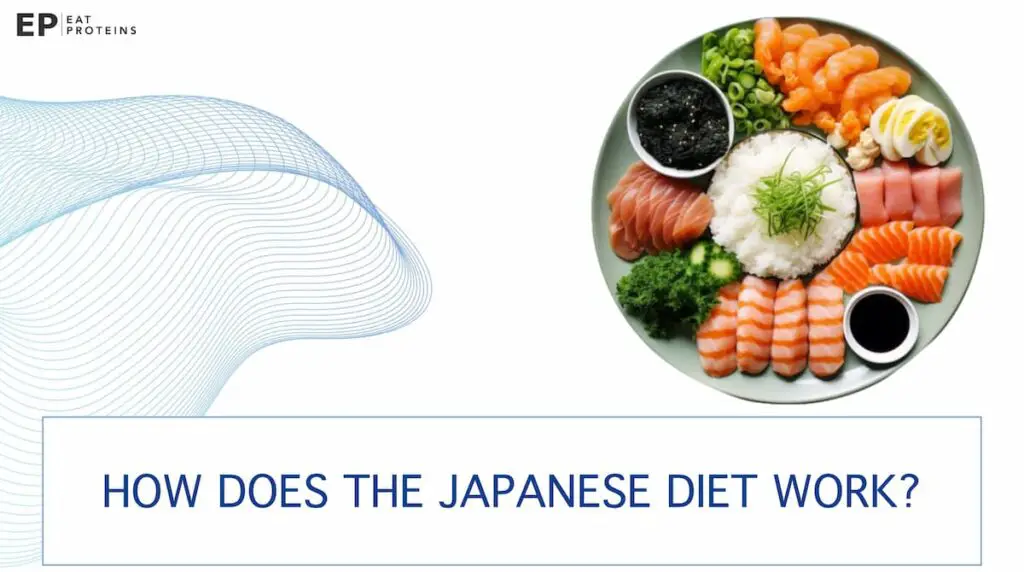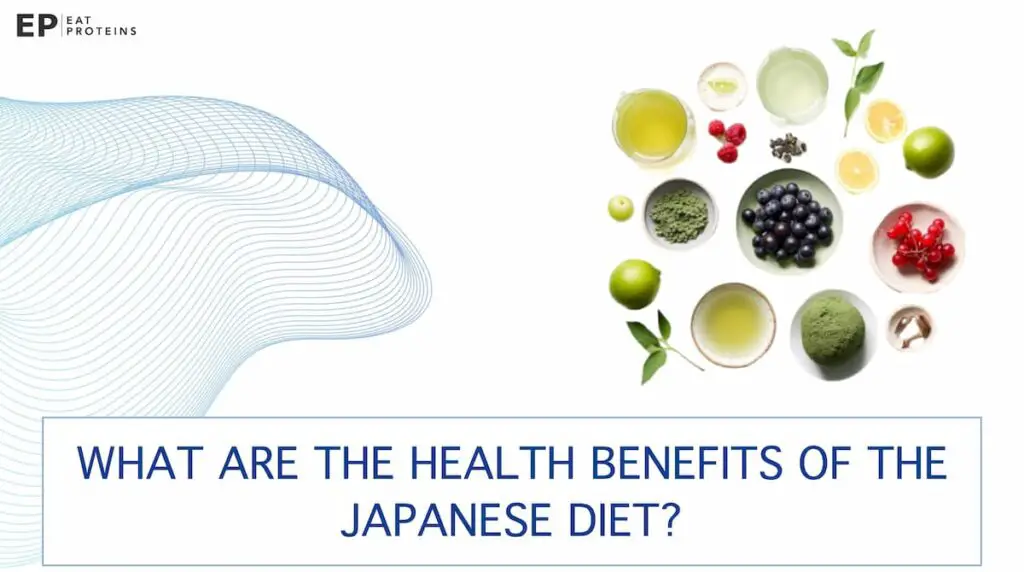The traditional Japanese diet consists of minimally processed, seasonal foods served in small dishes (between 10-13 cm in diameter). It emphasizes natural flavors without sauces or seasonings and is rich in rice, noodles, fish, tofu, natto, seaweed, fruits, and vegetables.
The Japanese diet is low in added sugars and fats, and meals typically consist of staple food, soup, main dish, and sides. The traditional Japanese diet offers numerous health benefits, including improved digestion, healthy weight management, reduced risk of heart disease and type 2 diabetes, and a longer life expectancy in Japan.
According to a 2020 study by Satoshi Sasaki from The University of Tokyo, various studies and articles have self-defined the Japanese diet, and some even use government-proposed definitions, but a standardized, nutrition-based definition has not been established.
Therefore, while the diet is commonly associated with health benefits, it’s essential to first define what the Japanese diet means from a nutritional standpoint before making definitive claims about its health advantages.
This article covers a time-honored way of eating that has been practiced for centuries in Japan, the power of minimally processed, and seasonal foods served in small portions.
What is the Japanese diet?
The Japanese diet, also known as Washoku, is a traditional dietary pattern associated with low-calorie intake and a lower body mass index (BMI) compared to other populations. According to a 2018 study by Ana San Gabriel and Kumiko Ninomiya, the Japanese diet is rich in fish, soybean products, and vegetables, and low in animal fat and meat.
It relies heavily on the concept of umami, a taste that enhances palatability and may have links to the diet’s health benefits. The study suggests that the umami taste, which is abundant in traditional Japanese foods, could support healthy eating by enhancing the palatability of low-sodium, nutritious foods, though more research is needed to fully understand its nutritional implications.
While the Japanese diet, often associated with longevity and overall well-being, focuses on balanced nutrition, the scientific definition of what precisely constitutes the “Japanese diet” remains under debate, as evidenced by a review from Working Group 1 of the Healthy Diet Research Committee of the International Life Sciences Institute Japan.
What is the Japanese Okinawa diet?
The Japanese Okinawa diet is primarily plant-based, rich in root vegetables like sweet potatoes, as well as green and yellow vegetables and soybean-based foods. It also includes moderate amounts of marine foods, lean meats, and fruits, resembling other heart-healthy diets like the Mediterranean and DASH diets.
One of its key features is a healthy fat profile that is higher in mono and polyunsaturated fats and rich in omega-3s, which may contribute to reduced inflammation and optimized cholesterol levels. This diet is associated with a lower risk of cardiovascular disease and other age-related diseases, likely due to its high phytonutrient content, low caloric density, and potential to modulate aging-related biological pathways.
How does the Japanese diet work?
The Japanese diet promotes healthy and sustainable dietary patterns by emphasizing high fish and soybean consumption while limiting animal fat and meat.

This traditional diet, known as Washoku, is rich in umami taste, primarily elicited by the free amino acid glutamate.
The optimal concentration of glutamate ranges from 0.04% to 1.6%, and it enhances the palatability and acceptability of foods. By incorporating umami-rich ingredients and promoting small portion sizes, the Japanese diet helps decrease overall energy intake and maintain a lower BMI.
The Japanese traditional diet also encourages the consumption of a variety of seasonal foodstuffs, cooking methods with abundant water, and the value placed on health and family ties.
How does the Japanese diet contribute to weight loss?
The Japanese diet is known for its emphasis on soybeans/soybean-derived products, seafood, and vegetables, followed by rice and miso soup. These foods are naturally low in calories and high in nutrients, contributing to weight loss and overall health.
According to a 2018 study by Nozomu Suzuki from Kyoto University, epidemiological studies show that the Japanese diet is diverse but can be categorized into 16 key components. The top three components are soy-based foods, seafood, and vegetables.
The diet is rich in unrefined carbohydrates and features a moderate intake of protein, along with a healthy fat profile that is higher in mono- and polyunsaturated fats. Collectively, these factors make the Japanese diet a sustainable choice for weight loss, as it offers a balanced intake of nutrients while naturally limiting calorie consumption.
How does the Japanese diet contribute to longevity?
The Japanese diet is believed to contribute to longevity due to its emphasis on nutritious and balanced food choices. The average total energy intake in Japan is around 1,898 kcal/day. Protein intake is within the recommended range, with the highest intake observed in the 70s age group.
The consumption of red meat in the Japanese diet exceeds the upper limit of the global reference of the Planetary Health Diet, particularly in subjects in their 40s. Fish consumption increases with age, especially in the 70s.
What are the health benefits of the Japanese diet?
The Japanese diet offers numerous health benefits, as highlighted in the 2023 study conducted by Marika Nomura of Nagasaki University. These benefits include a reduced incidence of obesity and non-communicable diseases related to diet.

- Longevity: The Japanese diet has been associated with increased life expectancy. The country has one of the highest life expectancy rates in the world, which can be attributed in part to its dietary habits.
- Heart Health: The Japanese diet is rich in fish, which is a great source of omega-3 fatty acids. These healthy fats have been shown to reduce the risk of heart disease, lower blood pressure, and decrease the likelihood of developing clogged arteries.
- Weight Management: The Japanese diet typically includes smaller portion sizes and a wide variety of vegetables, resulting in a lower calorie intake. This can contribute to weight management and a lower risk of obesity-related diseases.
- Lower Risk of Type 2 Diabetes: The Japanese diet emphasizes whole grains, vegetables, and lean protein sources. These choices tend to have a lower glycemic index and can help regulate blood sugar levels, reducing the risk of developing type 2 diabetes.
- Reduced Risk of Cancer: The Japanese diet includes a high consumption of cruciferous vegetables, such as broccoli, cabbage, and kale. These vegetables are rich in antioxidants and have been associated with a decreased risk of various types of cancer, including lung, colorectal, and breast cancer.
- Digestive Health: The Japanese diet contains a significant amount of dietary fiber from vegetables, whole grains, and legumes. This fiber promotes a healthy digestive system, prevents constipation, and supports overall gut health.
- Brain Health: The Japanese diet includes foods that are beneficial for brain health. Fish, rich in omega-3 fatty acids, has been linked to a reduced risk of cognitive decline and Alzheimer’s disease. Additionally, green tea, commonly consumed in Japan, contains compounds that may improve brain function and protect against neurodegenerative diseases.
How is the Japanese diet beneficial for long-term health?
The Japanese diet is beneficial for long-term health due to its emphasis on whole grains, fruits, vegetables, and seafood. These components provide essential nutrients, antioxidants, and fiber, which are associated with lower risks of chronic diseases such as heart disease, stroke, and certain cancers.
Additionally, the Japanese diet traditionally includes smaller portion sizes (between 3.94-5.12 inches in diameter) and a balanced intake of protein from sources like tofu and fish, which can help maintain a healthy weight. What’s more, the diet’s focus on cultural practices such as mindful eating and cooking methods like grilling and steaming contributes to overall well-being.
What are the health risks of the Japanese Diet?
The following list outlines the potential health risks of the Japanese diet.
- Excessive Intake of Red Meat: Consuming too much red meat is linked to increased risks of type 2 diabetes and certain cancers. To mitigate this, it’s advisable to limit red meat consumption and focus on other protein sources like fish and legumes.
- Shift Towards High Fat and Protein Intake: The modern Japanese diet has shifted towards foods high in fat and protein, contributing to obesity and related health problems. Sticking to the principles of the traditional Japanese diet, which emphasizes low-fat foods and balanced meals, can help mitigate these risks.
- Environmental Impact of Red Meat Consumption: The production of red meat has a high environmental cost, affecting sustainability. Reducing red meat consumption and choosing more environmentally friendly protein sources like fish or plant-based proteins can lessen this impact.
- High Sodium Content: Traditional Japanese dishes often contain high levels of sodium from soy sauce, miso, and pickled foods, which can lead to hypertension and cardiovascular issues. Being mindful of portion sizes and opting for low-sodium alternatives can help manage this risk.
- Potential for Nutrient Deficiencies: The traditional Japanese diet could result in inadequate intake of essential nutrients like vitamin D, calcium, and vitamin B12. Incorporating fortified foods or supplements can address these deficiencies.
How to start a Japanese Diet?
To start a Japanese diet, begin by incorporating commonly used ingredients like rice, fish, and vegetables into your meal planning, and focus on portion control and cooking techniques such as steaming and grilling.

- Stock up on common Japanese ingredients like rice, fish, and vegetables. Aim to have these as the base for most of your meals.
- Plan your meals around these key ingredients. For example, have fish twice a week, rice as a staple, and vegetables in every meal.
- Stick to typical Japanese portion sizes, which are generally smaller than Western portions. For instance, limit rice to one cup per meal.
- Employ cooking methods like steaming, grilling, or using a wok. These techniques are not only healthy but also authentic to the Japanese culinary style.
- Pay attention to the aesthetics of your food arrangement. Aim to include at least three colors in each dish for visual appeal.
- Educate yourself on the nutrients commonly found in Japanese foods, such as omega-3s in fish and antioxidants in vegetables.
- Aim for an average of 1,800 to 2,200 calories per day, in line with the caloric intake commonly seen in a traditional Japanese diet.
- Allocate time for meal preparation and eating. Aim to spend at least 30 minutes on meal preparation and 20 minutes on eating to savor your food.
- Plan a budget for your grocery shopping. A weekly budget of around $50 to $70 can be sufficient for a single person following a Japanese diet.
What foods are included in a typical Japanese diet plan?
In a typical Japanese diet plan, the main staples include rice, fish, and a variety of vegetables. You’ll also commonly find soy-based products like tofu, along with other protein sources such as chicken and pork.
- Rice
- Fish (salmon, tuna, mackerel)
- Vegetables (spinach, cabbage, carrots)
- Seaweed (nori, wakame)
- Tofu and other soy products
- Chicken
- Pork
- Noodles (soba, udon)
- Fruits (apples, bananas, oranges)
- Miso soup
- Sushi and sashimi
- Tempura (fried vegetables and seafood)
- Pickled vegetables (tsukemono)
- Green tea
- Sake and other traditional beverages
What foods should be avoided in a Japanese diet plan?
In a traditional Japanese diet plan, it’s advisable to avoid processed foods, sugary snacks, and high-fat dairy products.

These foods are not in line with the diet’s emphasis on natural, whole foods and balanced nutrition.
- Processed meats (like sausages and hot dogs)
- Sugary cereals
- Soda and sugary drinks
- Fast food items (like burgers and fries)
- High-fat dairy products (like whole milk and cream)
- Snack foods high in sugar and salt (like chips and candy)
- Pre-packaged meals with high sodium content
- Baked goods high in sugar and fat (like cookies and cakes)
- Deep-fried foods (like tempura and fried chicken)
What does the Japanese diet meal plan look like?
The Japanese diet meal plan typically consists of three balanced meals per day, featuring a variety of fish, seafood, tofu, vegetables, and fruits. Each meal often includes a staple like rice or noodles, along with side dishes such as miso soup, pickled vegetables, and a protein source like fish or tofu.
| Day | Breakfast | Lunch | Dinner |
|---|---|---|---|
| Monday | Miso Soup and Rice | Sashimi and Salad | Grilled Fish and Steamed Rice |
| Tuesday | Pancakes with Matcha and berries | Soba Noodles and Tempura | Tofu Stir-Fry and Brown Rice |
| Wednesday | Tofu Scramble and Seaweed | Teriyaki Chicken and Rice | Sushi Rolls and Miso Soup |
| Thursday | Pancakes with Matcha & Berries | Udon Noodles and Vegetable Soup | Yakitori Skewers and Rice |
| Friday | Green Smoothie and Rice Cake | Bento Box with Mixed Sides | Ramen with Seafood |
| Saturday | Oatmeal with Azuki Beans | Okonomiyaki (Savory Pancake) | Beef and Broccoli Stir-Fry |
| Sunday | Chia Pudding with Fresh Fruits | Onigiri (Rice Balls) and Salad | Tonkatsu and Cabbage Salad |
What are some popular Japanese diet recipes?
Some popular Japanese diet recipes that are both flavorful and nutritious include Sashimi, Miso Soup, and Soba Noodles. Sashimi consists of fresh, thinly sliced raw fish or seafood and is high in omega-3 fats and protein.
Miso Soup is made from fermented soybeans and often includes seaweed or tofu, offering a rich source of probiotics and antioxidants. Incorporating these dishes into your meal plan can support weight loss goals and align with the principles of the traditional Japanese diet.
What are the scientific facts about the Japanese diet?
The following list shows scientific facts about the Japanese diet.
- The Japanese diet is associated with low rates of obesity and diabetes compared to regional averages, with only 4.3% of adult women and 6.0% of adult men in Japan living with obesity.
- Japan is on track to meet the targets for reducing childhood stunting (7.1%) and has a lower prevalence of childhood wasting (2.3%) compared to the regional average.
- However, Japan has not made progress in reducing anemia among women of reproductive age (19.0% affected) and has not achieved the target for low birth weight infants (9.5%).
- Data is insufficient to assess Japan’s progress in achieving exclusive breastfeeding and wasting targets.
How long can you do the Japanese diet for?
The duration of following a Japanese diet varies depending on the specific type of diet you choose. Some are short-term plans like the Japanese 2-Day Diet, while others like the Japanese Longevity Diet are designed for long-term or even lifetime adherence.
What is the role of water in the Japanese diet?
The role of water in the Japanese diet is vital for maintaining hydration and supporting overall health. Water is a fundamental component of the human body and is essential for various physiological functions, including digestion, nutrient transport, temperature regulation, and waste removal.
What are the types of Japanese diet?
The types of Japanese diets vary in focus, from longevity and bodybuilding to veganism and menopause management. Some of the popular types are listed below.

- Typical Japanese Diet: This diet emphasizes rice, fish, vegetables, and fermented foods like miso and pickles. The main goal is to maintain everyday health and well-being, catering to a broad audience. However, it may not meet the needs of those with specific dietary restrictions or health conditions.
- Japanese Pregnancy Diet: Focused on foods that are rich in folic acid, calcium, and iron, this diet is designed to support the nutritional needs of expectant mothers. While it aims to provide essential nutrients for pregnancy, it might not be suitable for women with certain medical conditions.
- Macrobiotic Japanese Diet: Based on whole grains, vegetables, and legumes, this diet aims to balance the body’s natural energy. It is touted for its potential to improve digestion and overall well-being but may lack certain essential nutrients like vitamin B12.
- Japanese Okinawa Diet: Also known as the Japanese longevity diet, primarily consists of vegetables, tofu, and seaweed, aiming to emulate the diet of the long-lived people of Okinawa. The diet’s function is to promote longevity and decrease the risk of chronic diseases. Its limitations include a low protein content, which may not be suitable for everyone.
- Japanese Bodybuilding Diet: Focuses on high-protein foods like fish and lean meats, along with carbohydrates from rice. The function is to support muscle growth and athletic performance. However, it may not be balanced enough for general health maintenance.
- Japanese Water Diet: Encourages drinking water upon waking and before meals. The function is to promote weight loss by making one feel full, thus reducing caloric intake. The downside is that it may encourage water retention and doesn’t offer a comprehensive nutritional plan.
- Japanese Keto Diet: The Japanese Keto Diet is a variation of the standard ketogenic diet, which is a high-fat, low-carbohydrate diet. In this version, traditional Japanese foods that fit the keto macronutrient profile are incorporated.
- Vegan Japanese Diet: Excludes all animal products and focuses on plant-based foods like tofu, vegetables, and grains. While it aims to be ethically sound and environmentally friendly, it may lack certain essential nutrients like vitamin B12 and omega-3 fatty acids.
- Japanese Vegetarian Diet: Similar to the vegan version but allows for some animal-derived products like dairy and eggs. It aims to be a more flexible yet ethical eating plan. However, like the vegan version, it may lack certain nutrients.
- Japanese Menopause Diet: Designed to focus on foods that alleviate symptoms of menopause and is specifically targeted at women going through this life stage. It includes foods like tofu and fish that are rich in omega-3s, however, it may not be comprehensive enough to address overall health.
What is unique about the Japanese Okinawa diet?
The Japanese Okinawa diet is unique in its emphasis on low-calorie, nutritionally dense foods, particularly rich in phytonutrients, antioxidants, and flavonoids. It features a high intake of orange-yellow root vegetables like sweet potatoes, as well as green leafy vegetables, setting it apart from other traditional diets.
This diet is also exceptionally low in saturated fat and high in carbohydrates, mainly derived from plant-based sources. The traditional Okinawa diet includes foods such as herbs and spices, which are regularly consumed and often regarded as “functional foods.” These items are currently under research for their potential health-enhancing properties.
How is the Japanese diet different from Western diets?
The Japanese diet differs from Western diets in several ways.
- High in Seafood: The Japanese diet includes a variety of fish and other seafood, which are rich in omega-3 fatty acids and protein.
- Rice-Centric: Rice is a staple in the Japanese diet, often served with every meal.
- Vegetable Focus: A wide range of vegetables are included, contributing to a diet rich in vitamins, minerals, and fiber.
- Fermented Foods: Foods like miso, natto, and fermented soy are commonly consumed, providing beneficial probiotics.
- Fewer Processed Foods: The diet is generally low in processed foods and high in whole, natural foods.
- Low in Sugary Drinks: Beverages like tea are more common than sugary sodas and juices.
- Portion Control: Meals are often served in smaller portions, with a focus on balance and variety.
How does the Japanese diet compare to the Mediterranean diet?
The Japanese diet and the Mediterranean diet share several similarities in terms of their health implications. Both diets emphasize the consumption of nutrient-dense foods that are low in calories and high in antioxidants, flavonoids, and phytonutrients.
They also have a low glycemic load and promote reduced intake of saturated fats, refined grains, and sugars. These dietary patterns contribute to decreased risks of cardiovascular disease, certain cancers, and other chronic diseases by reducing oxidative stress.
Is the Japanese diet considered a healthy diet?
Yes, the Japanese diet is widely considered a healthy diet due to its emphasis on fish, vegetables, and whole grains, while being low in saturated fats and processed foods. The diet is known for being rich in nutrients and antioxidants, contributing to lower rates of heart disease and longer lifespans in Japan.
How can you access the Japanese diet plan in PDF format?
To access the Japanese diet plan in PDF format, you can search for reputable sources that offer downloadable PDFs on their websites or online platforms. Alternatively, you can create your own Japanese diet plan and save it as a PDF using document editing software.
